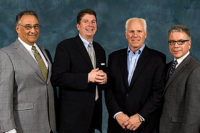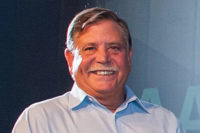There are a lot of new technologies and services entering the security industry that affect monitoring. From apps and smartphones to managed access control, personal emergency response (PERS) and live video monitoring, central stations are tasked with making the technologies a valid industry offering. Today’s central stations need multi-skilled/educated operators to do their jobs well and maintain the integrity of signal handling in the central station. SDM asked leading central stations around the industry how their operator training is changing in the new era. They said success begins with picking up the pace of training — and choosing the right operator candidates, trainers and training methods.
The pace of technology change is a big driver for new training approaches today.
“In the past, we had the luxury of focusing on new hires and employee retention because basically everything was the same year after year. With new technologies coming to market and new applications on mobile devices, our training has had to move from just the classroom to the field, the call center floor and to our own tool development,” describes Jamie Haenggi, chief marketing and customer experience officer, Protection 1, Chicago, Ill.
Haenggi shares the company’s call center now has iPads, various mobile devices and free apps for agents to download on their own phones, enabling them to do things such as arm and disarm, view video, capture video, turn on and off lights and more. The company also is in the process of rolling out an app simulation.
“This will enable our reps on the phone to virtually ‘see’ what the customer is seeing when they are trying to help them walk through a particular scenario,” Haenggi explains.
Affiliated Response, Union, N.J., quickened the length and intensity of its new hire training and added to its continuing education programs, reports Harvey Cohen, general manager. The central station also has partnered with manufacturers to step up its training.
“We hold recurring training sessions with industry manufacturers to keep our employees informed of the latest service offerings and technologies within the industry. With our newest offering, InView, our video verification platform, Affiliated implemented a specialized training syllabus with coursework. Each one of our operators and dealer support staff has gone through extensive training to properly handle and verify alarm signals with video support,” Cohen says. Affiliated Response also has implemented training to deepen its operators’ skill sets for handling video verification and mobile PERS offerings.
By closely partnering with manufacturers Rapid Response’s teams can start working with the latest technology and products before they are even released.
“Our training is customized to fit each roll out and it is ongoing as enhancements are made,” says Morgan Hertel, vice president of operations, Rapid Response Monitoring, Syracuse, N.Y.
The company’s operators also are trained for enhanced video monitoring services through Rapid’s integration with Immix Cloud by SureView Systems.
“Combined with the robust backbone of our unique implementation of Stages, Immix Cloud allows our critical-event specialists to monitor a continuously expanding suite of video platforms through a single user interface,” Hertel describes.
Dynamark’s training for both PERS and mobile devices is specialized, and limited to a select few staff due to the level of IT savvy required, explains Keith Godsey, vice president of central station operations, Dynamark Security Centers, Hagerstown, Md.
Operators are also trained on video monitoring to make sure they are correctly interpreting what they see. “We use only our more experienced operators for such services, and work with the manufacturers that we support to help ensure that the signals are handled quickly and efficiently,” Godsey says.
Choosing the Operators
Jim McMullen, president and chief operations officer at COPS Monitoring, Williamstown, N.J., points out that before any investment in training is made, it must be matched with the right person.
“We learned decades ago that even the best training program won’t work on the wrong person; successful training depends on choosing the right person for the position,” shares McMullen.
Because being a dispatcher is such an important job, the company has rigorous testing, hiring, training, and ongoing evaluation programs that were all designed with the assistance of an industrial psychologist, and only the applicants with the proper blend of professionalism, personality attributes, ability, and sense of duty necessary are hired.
Acadian Monitoring Services, Lafayette, La., carefully selects the operators it trains for remote video monitoring.
“We require individuals with a strong sense of situational and tactical awareness in order to effectively monitor video accounts, use proper judgment and initiate the correct response procedures. We typically seek individuals with a background in law enforcement or military service or other industries peripheral to those,” says Blane Comeaux, president, Acadian Monitoring.
Choosing the Right Trainers/Training
The best trainers are those who have a passion for learning themselves. Whenever SentryNet, Memphis, Tenn., adds services, its training program is updated as well, shares Anna Tate, dealer relations manager for SentryNet. Because updating the training program is a never-ending responsibility of its trainers, the company has always kept full-time trainers in both of its central stations in Memphis and Pensacola, Fla.
To account for different learning styles, Memphis trainer Shirley Goodman implements various modules of instruction on a regular basis, whether it is a quiz, a crossword puzzle or a disaster backup exercise, Tate reports.
Over the years, SentryNet’s training has become more multidimensional, moving from only classroom instruction to hands-on applications with products, You Tube videos, listening exercises and practicing the software with demo accounts. “Variety is the key to making sure that operators are exposed to various learning opportunities. We understand that people have different learning styles and we make sure that each person’s training accommodates their strengths,” Tate says.
While classroom training is important for ongoing employees, Protection 1 also has invested in a Learning Management System (LMS) that allows representatives to do video-based training right from their computers — or even at home. Post testing ensures retention and provides tracking and reporting to supervisors.
In addition to training, making sure that representatives have a resource is key to education on technology. “Protection 1 Tech Help online resource is available to everyone in the company,” says Joe Sanchez, senior vice president of Operations, Protection 1.
The right training builds into the fundamental principle of service. Only after exercising extraordinary measures to pinpoint the right candidate will COPS Monitoring make the investment in their training so they can properly serve its dealers and customers, according to McMullen.
“Because specialized ongoing training has always been a mainstay of our operations, the rate of training hasn’t necessarily changed, but we are continually expanding the program to include emerging technologies and enhance service,” he says.
Pairing the right operators with the right training on the new technologies broadens opportunities — and enhances service across the board.
Crossing Borders & Cultures in the Monitoring Center
In addition to technology and service changes, there are language barriers to consider as the industry widens its reach. SDM asked central stations about any language considerations they may make and whether they address the issue of bilingual operators.
“As a company with customers located throughout the United States, Acadian monitors many accounts where a language other than English is used. While we have recently seen an increase in Mandarin-speaking customers, our primary non-English speaking customers are Spanish speaking,” reports Blane Comeaux, Acadian Monitoring Services.
To provide bilingual services to its Spanish-speaking customer base Acadian maintains at least one bilingual operator on staff 24/7, and two or three standby bilingual employees from other Acadian divisions are ready to act as a translator if needed during higher volumes of calls. For those languages where it does not have a fluent operator it relies on a translation service line.
Protection 1 also relies on both bilingual operator skills and translation technology.
“At Protection 1, we do have many employees that are bilingual in Spanish and a few other languages, and if available, we will engage a bilingual employee with a customer. If not available or speaking a language we don’t have skills in, we can easily access our 24/7 Language Line Services, which has the capabilities to interpret more than 170 languages,” Haenggi shares.
Guardian Protection Services, Warrendale, Pa., SDM’s 2013 Dealer of the Year, has had bilingual operator capability since 2003, and has seen its need for bilingual operators grow as it has expanded its authorized dealer program into the western United States into states such as Arizona and California, states Mike Overby, vice president, Subscriber Services, Guardian Protection Services.
Vivint takes advantage of the college and LDS return missionary population in Provo to help staff its foreign-language needs. Plus, its St. Paul, Minn., office only posts for bilingual operators when it hires. “We pay bilinguists a little more to compensate them for their expertise,” says Norm Nelson, director of central station, Vivint, Provo, Utah
Rapid Response has bilingual (English/Spanish speaking) critical-event specialists on staff at all times. The company added an intensive Spanish Language Program, and the instructor holds a Master’s Degree in education for Spanish. Staff members that enroll in the program become fluent in Spanish not only within the central station, but in other areas as they grow within the company.




















